Sea Trout Fishing Tactics
The approach to river night fishing for
sea trout
|
|
On warm nights, sea trout
will generally be more active and may be
taken on flies fished near the surface.
Most of my night fishing, even when
fishing late into the night, is done
using a floating line but I am normally
fishing relatively shallow water. I like
to fish in places where the current
speeds up. This may be towards the
shallowing pool tail but often simply
where the river narrows or shallows,
increasing the flow. This quickening of
the current helps in fishing our flies
and the sea trout seem to like faster,
shallower streams on mild nights. I like
to concentrate particularly on the
smoother streams, not the rough,
turbulent water you might find at the
heads of the pools. Once it is truly
dark, I will seek out those smoother
glides, sometimes little more than a
foot deep, yet with sufficient strength
of current to swing a fly round without
the need for much, if any, hand-lining.
When temperatures remain low, or drop
later in the night, sea trout become
less active, and may retreat to the
deeper parts of the pools, where it may
be necessary to switch to sinking lines
and possibly larger flies. We say then
that the sea trout have "gone down" for
the night, a term which describes the
settling of sea trout in deeper water
following an active period early in the
night.
| |
|
|
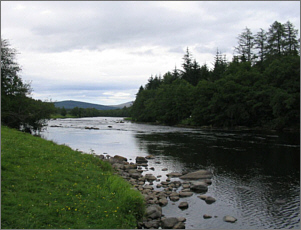 |
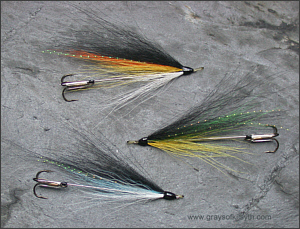 |
|
A nice pool
tail on the Spey |
Sea Trout
Needle Flies |
On a typical summer
night, if there is such a thing in sea
trout fishing, the sea trout will be at
their most active, and most likely to
take a fly, during the first hour or two
of darkness. Fish may be seen and heard
moving around the pools, perhaps jumping
clear of the water or making bow waves
as they swim in the shallow water of the
pool tails. They seem suddenly to have
woken from their daytime slumbers, to
revel in the safety and security of the
dark. When at sea, this would have been
a peak feeding time, searching out
shrimps or sand eels with the ebb and
flow of the tides. Now back in the
river, although they have no need of
food, the habit persists. Their guard
down, this is when the sea trout are
most likely to take a well fished fly.
This period of gay abandon can last an
hour or, if we are very lucky, it may
continue well into the night. Much
depends on air temperature. If there is
good cloud cover and the night remains
warm, the period of activity will
generally last longer. I am always happy
to hear the weather man forecast night
temperatures to drop no lower than 11
degrees. At some point, though, things
will usually go quiet. Suddenly, the sea
trout will seem to have gone, the river
lifeless. They have not gone, though,
they have simply "gone down", settled
comfortably in the deeper parts of the
pools, where they are less vulnerable,
harder to reach. They might still be
caught but we will have to work a bit
harder to tempt them than we did
earlier. We may now have to fish our
flies more deeply, perhaps more slowly,
in the deeper pools. Such places are not
so easily fished as the faster,
shallower streams but might, on
occasion, produce the best fish of the
night.
|
|
|
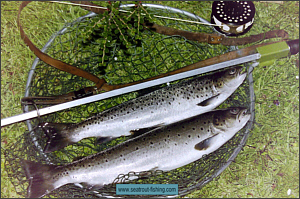 |
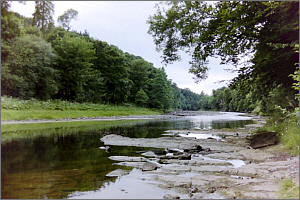 |
|
A nice brace
from the Border Esk |
Mill Stream,
Border Esk |
The secret, then, if there is one, in sea
trout fishing, is in being in the right place at the right
time. It is more than half the equation. Now, leaving aside
the obvious .... that, more often than not, the essential
requirement in putting you in the right place at the right
time is a healthy bank balance or a well placed acquaintance
... a nocturnal encounter with a willing sea trout is
not simply a matter of chance. Nor is such an encounter
likely to occur in any old pool on your chosen river.
Reliable taking places are sometimes few and far between and
not always easily identified. Without the benefit of local
advice, it may take many happy seasons of nocturnal
exploration to find the best spots, and even then they may
vary with the height of the river, time of night or time of
the season. Indeed, I would suggest that the greatest skill
a sea trout fisher can hope to acquire is the ability to
recognise potential taking places on a stretch of river,
especially an unfamiliar one. By comparison, tackle
selection is a trivial matter. Even the choice of fly is
relatively unimportant. Such a skill, of course, is not an
easy one to acquire. Even with a rich memory bank of past
experience, many are the mistakes we are destined to make
along the way in choosing a likely night cast for a sea
trout.
| |
|
|
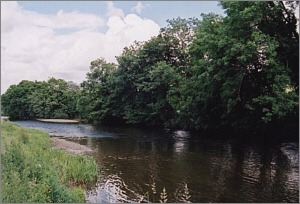 |
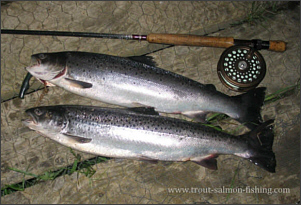 |
|
Sea Trout
water on the Towy |
A brace of
Spey Sea Trout |
To give an example of my own ineptitude in this
department, in my first season on the Crieff Angling Club
water on the River Earn, I concentrated my efforts on a
relatively short stretch of what I considered an eminently
fishy looking bit of water. One long tree lined pool, in
particular, just below Templemill, attracted my attention,
and I fished it hard for a month or two. I don't think I
even saw a fish in that pool, let alone hook one, all
season..... single minded determination?.... or just thrawn
stupidity? More recently, on the Spey, on exploring a new
section of river, I came upon the most perfect looking piece
of sea trout water, near the upper limit of the Grantown
Association water. I wondered why I had not discovered it
before but resolved to rectify my omission that very night.
I arrived early, in great anticipation, and was amazed to
have a whole quarter mile of perfect sea trout water to
myself, the jewel of which was a pool of maybe a hundred
yards in length, with fast water at the head running at a
depth of about five or six feet down the far bank, an easy
cast of twenty yards with the line swinging round in a
straight line at perfect pace all the way to the tail of the
pool, with the bonus of easy wading over shallow gravel down
the left bank..... not something you expect on association
water. I fished carefully down the whole length and saw only
one small sea trout jump in the tail of the pool.... the
pool seemed empty. In conversation with an experienced
visitor to the river, I later found that this pool rarely
produces sea trout. Yet, just a few hundred yards
above, on the Abernethy Association water, lie some of the
most productive sea trout pools on the river (see recent
favourite pool article "The Nethy Pool" in Trout &
Salmon magazine). I have learned, usually the hard way, that
not all pools are as productive as they might look. Location
is just about everything in sea trout fishing. Give me any
old fly..... a bit of black hair tied roughly to a hook
..... and
the ability to read a sea trout river...... and I'll be a
happy man!
Those
about to set out on their first sea trout season
will find some useful tips on where, when and how to
catch sea trout on the fly at night on British
rivers on the following page:
How to Catch a
Sea Trout |
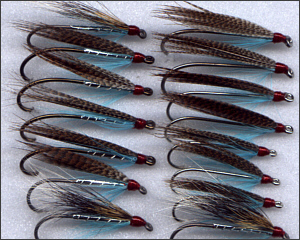
Medicine Chest
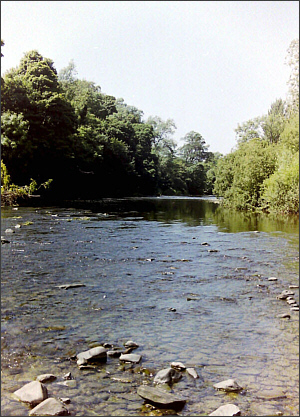
The River Annan
at Hoddom Castle
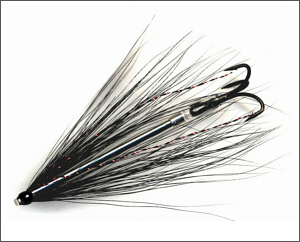
Sea Trout Needle Tube Fly
|